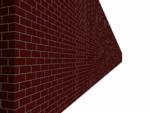TAPESTRY: The Art of Representation and Abstraction
Anti-aliasing: Examples
AntiAliasing Examples
These particular samples were not generated with Rhino or V-Ray, but they illustrate the general effects of aliasing (and anti-aliasing).
Anti-aliasing is often thought of in terms of lines and the edges of polygons, but it is probably more noticable and objectionable as an effect that occurs in small-scale high-contrast textures such as the brick patterns illustrated here. Up close, where the mortar lines are many pixels wide, there is no problem, only when the scale of the pattern has been reduced to sub-pixel size does the pattern begin to 'drop out' parts. This happens in a mathematically predictable way that depends on the interaction of two grids, one consisting of the screen pixels and one consisting of the pattern of pixels on the wall, producing a third pattern, called a Moire pattern. This is particularly noticable in the case of the temporal aliasing exhibited in the un-altered animation file (bwall.mov).
The file names indicate whether supersampling (ss) was used, and at what level (High, ss(hi); medium, ss(med); or low (ss(low)), and what level of shader anti-aliasing (shaa) was not used (shaa(off), shaa(hi), whether it was done in texture space (shaa(hitxtr), etc.). The number at the end of some names, suffixed by an "s" gives the number of seconds required for the rendering.
Last updated: October, 2015
.5s.jpg)
.jpg)
.jpg)
.53s.jpg)
.jpg)
.105s.jpg)
.110s.jpg)
.75s.jpg)

.jpg)
